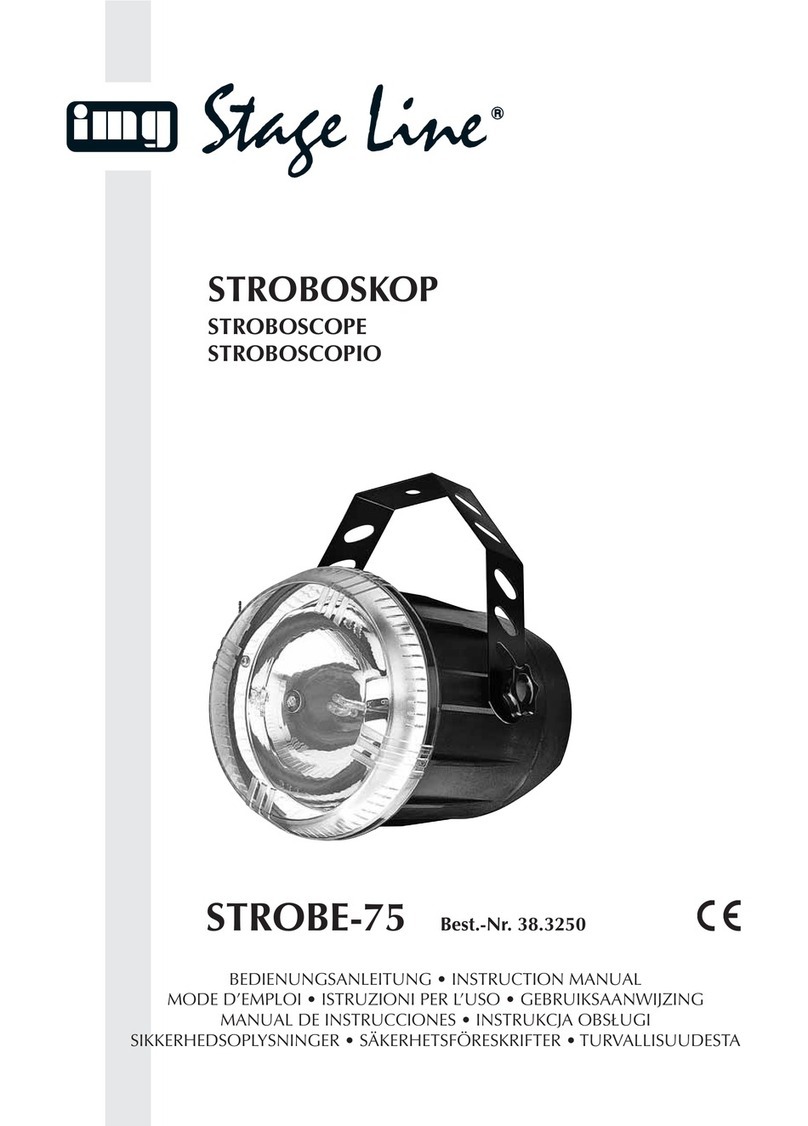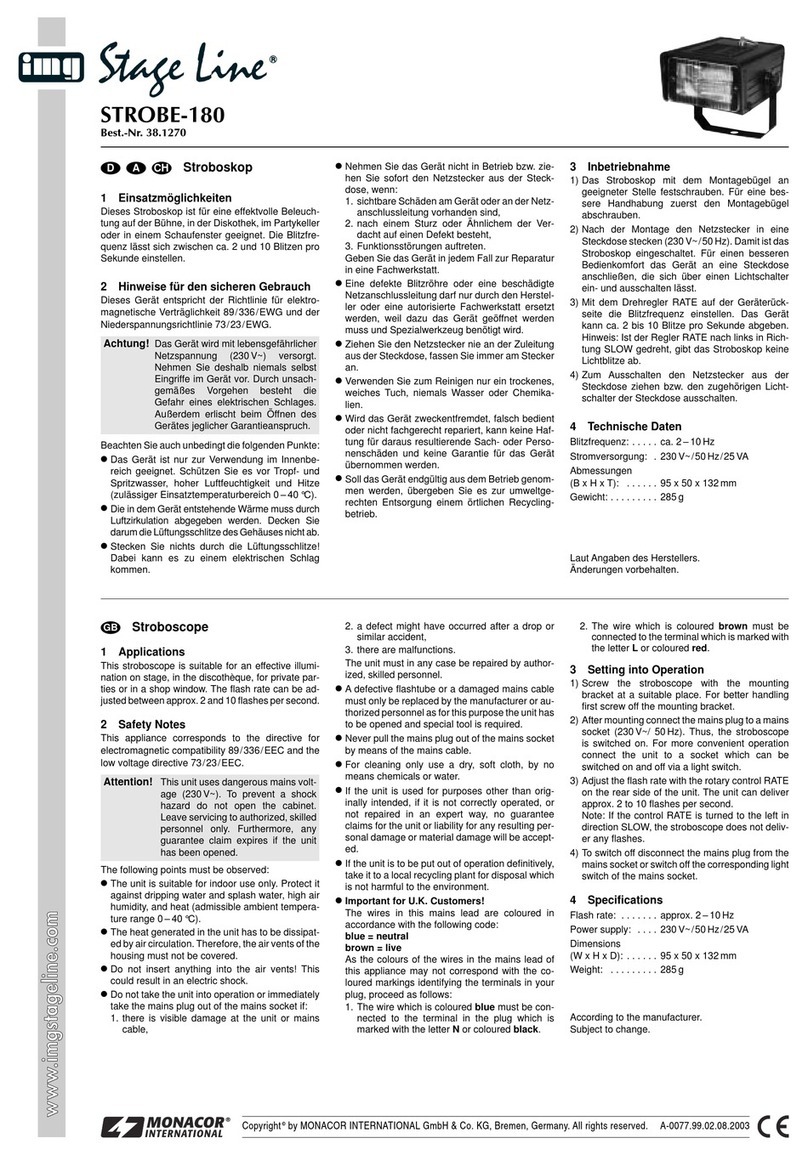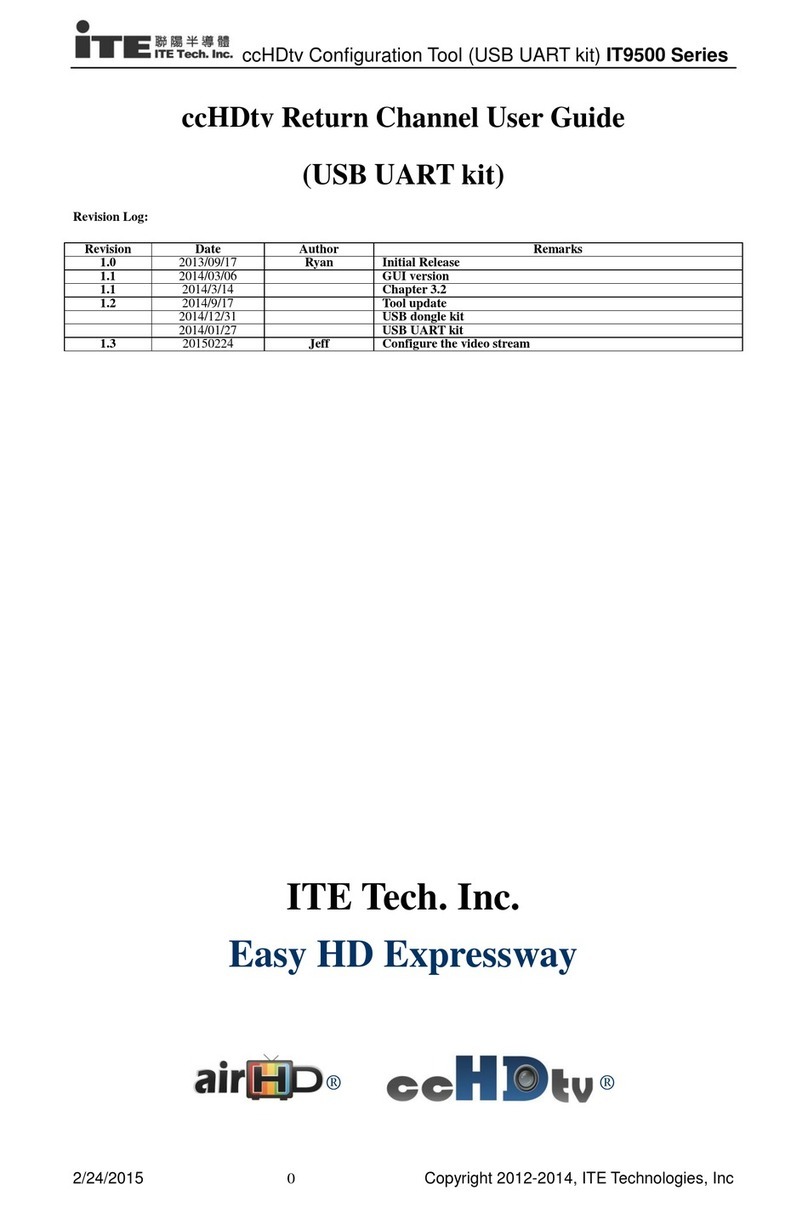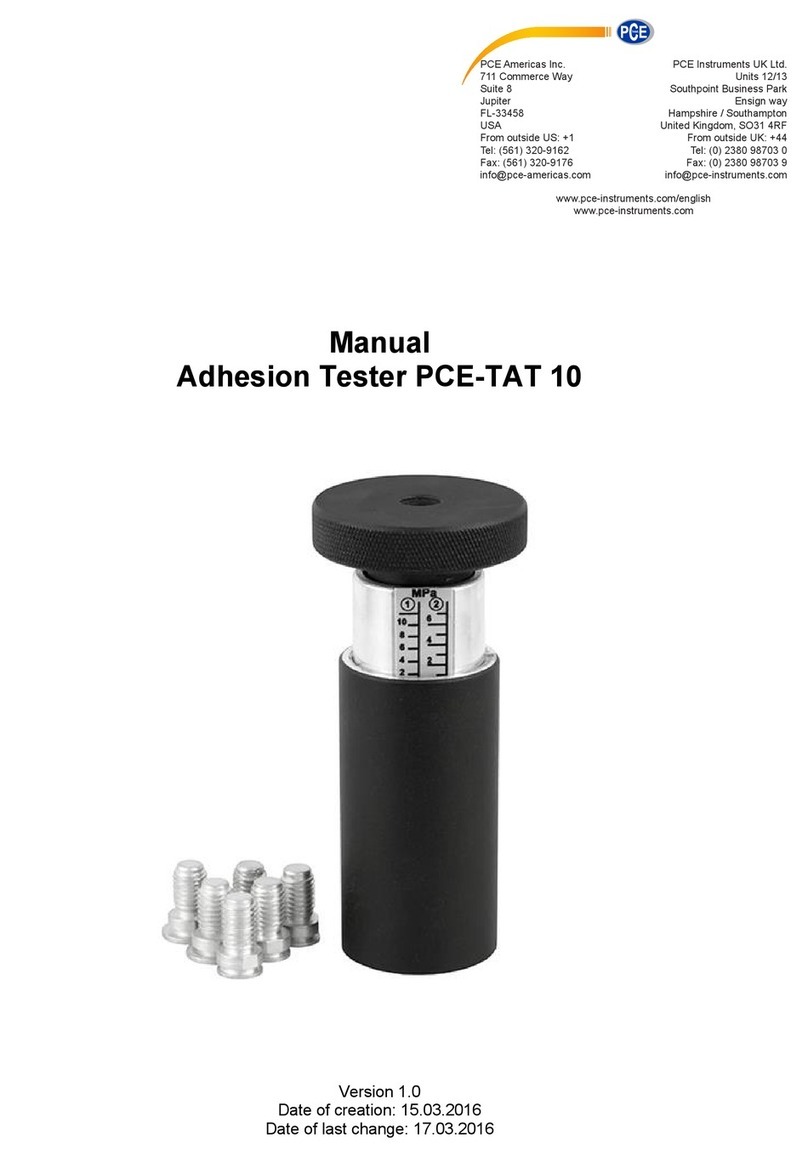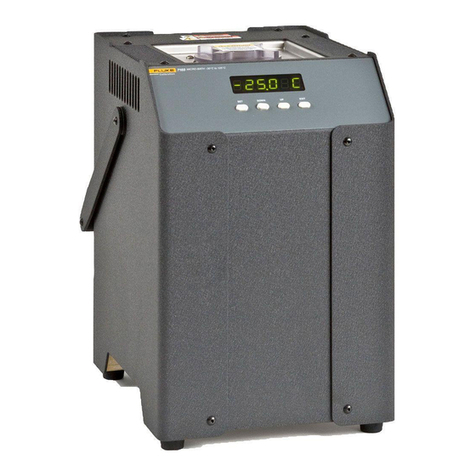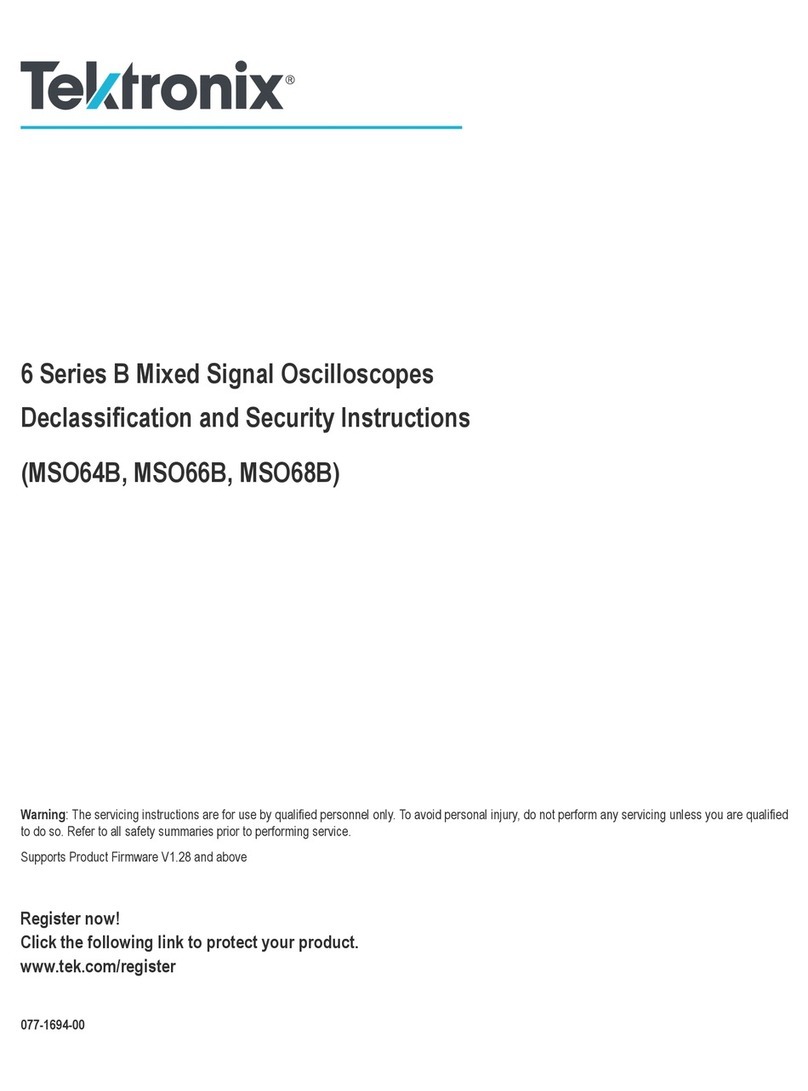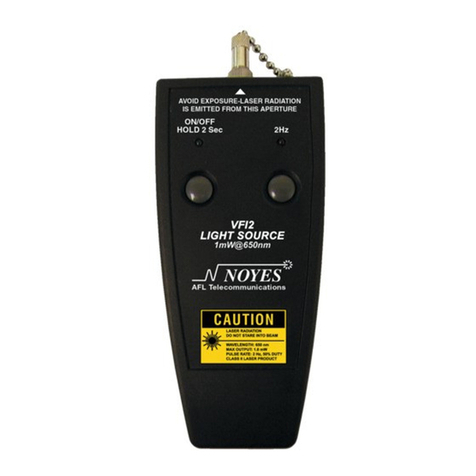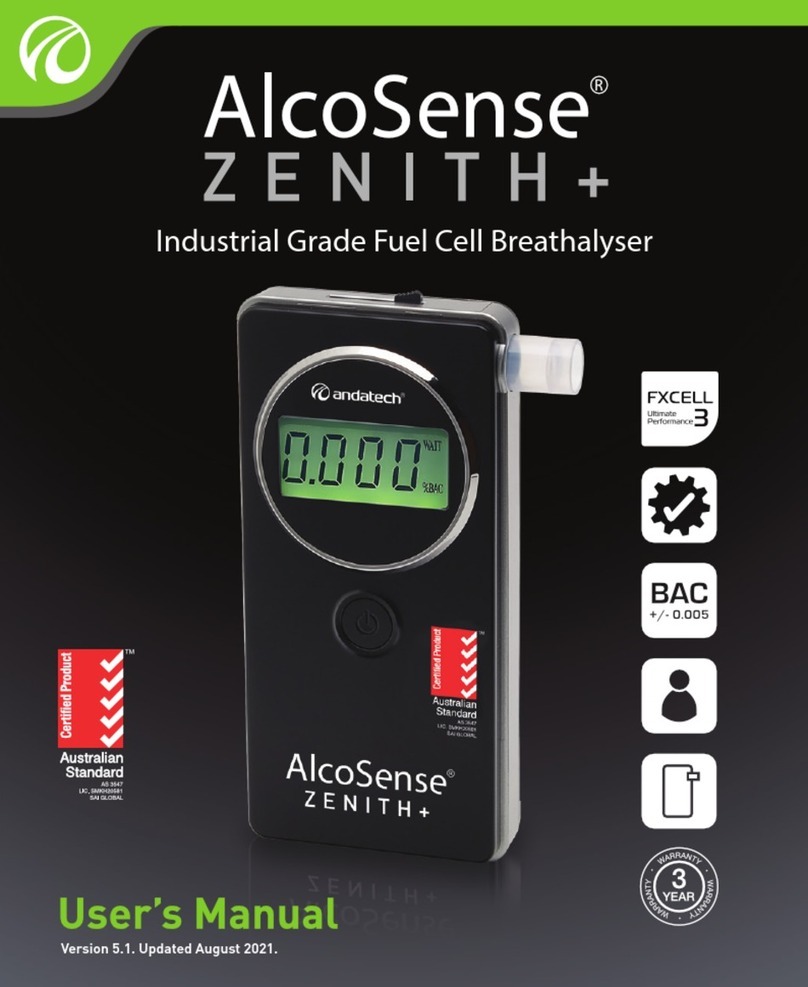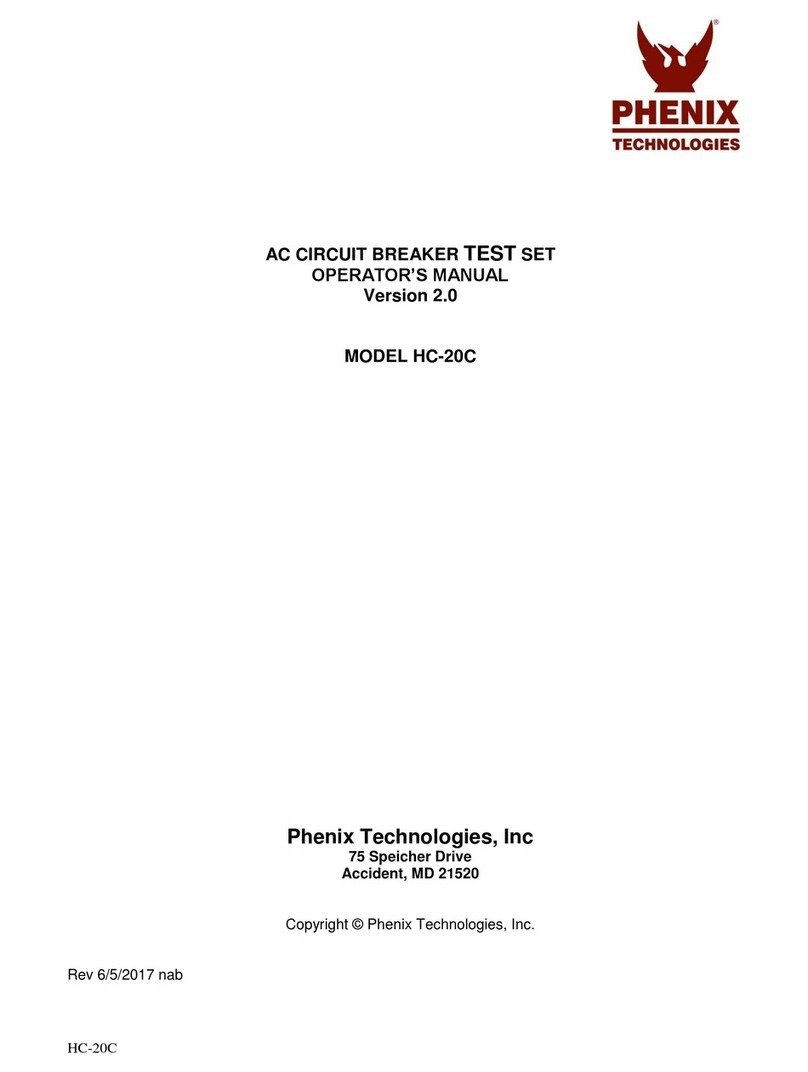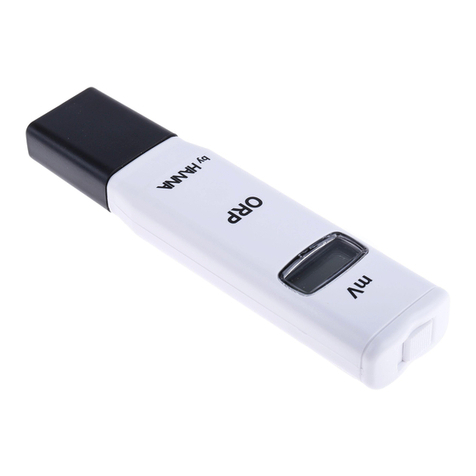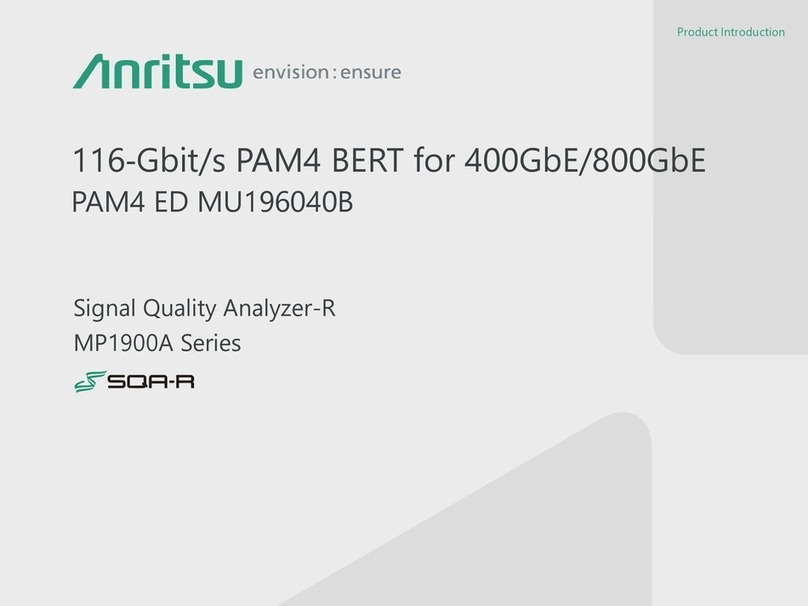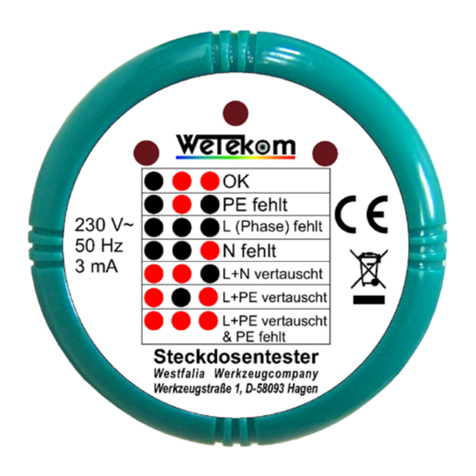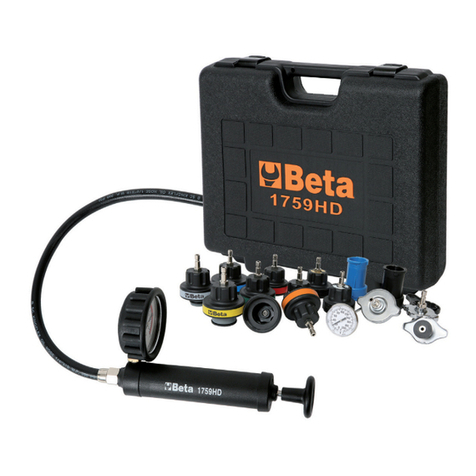IMG STAGE LINE DMX-1TEST User manual

DMX-TESTER
DMX TESTER
TESTEUR DMX
TESTER DMX
DMX-1TEST Best.-Nr. 38.2740
BEDIENUNGSANLEITUNG • INSTRUCTION MANUAL
MODE D’EMPLOI • ISTRUZIONI PER L’USO
MANUAL DE INSTRUCCIONES

2
1
6
7
8
11
12
2
3
4
5
9
10
13
14

3
Bevor Sie einschalten ...
Bitte lesen Sie diese Bedienungs-
anleitung vor dem Betrieb gründlich
durch. Nur so lernen Sie alle Funkti-
onsmöglichkeiten kennen, vermei-
den Fehlbedienungen und schützen
sich und Ihr Gerät vor eventuellen
Schäden durch unsachgemäßen Ge-
brauch. Heben Sie die Anleitung für
ein späteres Nachlesen auf.
Der deutsche Text beginnt auf Seite 4.
Before you switch on ...
Please read these operating instruc-
tions carefully prior to operating the
unit. Thus, you will get to know all
functions of the unit, operating errors
will be prevented, and yourself and
the unit will be protected against any
damage caused by improper use.
Please keep the operating instruc-
tions for later use.
The English text starts on page 8.
Avant toute mise en service ...
Lisez ce mode dʼemploi entièrement
avant toute utilisation. Uniquement
ainsi, vous pourrez apprendre lʼen-
semble des possibilités de fonctionne-
ment de lʼappareil, éviter toute manipu-
lation erronée et vous protéger, ainsi
que lʼappareil, de dommages éven-
tuels engendrés par une utilisation in-
adaptée. Conservez la notice pour
pouvoir vous y reporter ultérieurement.
La version française commence à la
page 12.
Prima di accendere ...
Leggete attentamente le istruzioni
prima di mettere in funzione lʼappa-
recchio. Solo così potete conoscere
tutte le funzionalità, evitare comandi
sbagliati e proteggere voi stessi e
lʼapparecchio da eventuali danni in
seguito ad un uso improprio. Conser-
vate le istruzioni per poterle consul-
tare anche in futuro.
Il testo italiano comincia a pagina16.
D
A
CH
GB
F
B
CH
I
EAntes de cualquier instalación ...
Por favor, lea estas instrucciones de
uso atentamente antes de hacer fun-
cionar el aparato. De esta manera
conocerá todas las funciones de la
unidad, se prevendrán errores de
operación, usted y el aparato estarán
protegidos en contra de todo daño
causado por un uso inadecuado. Por
favor, guarde las instrucciones para
una futura utilización.
La versión española comienza en la
página 20.
wwwwww..iimmggssttaaggeelliinnee..ccoomm
®

Auf der Seite 2 finden Sie alle beschriebe-
nen Bedienelemente und Anschlüsse.
1 Übersicht der Bedienelemente
und Anschlüsse
1LC-Display
2Anzeige für das DMX-Eingangssignal
3Taste MENU zum Aufruf der Menüpunkte
4Taste MODE zur Wahl verschiedener Be-
triebsarten und zur Anwahl der Parameter
5Tasten ADDRESS/CHANNEL zur Einstel-
lung der DMX-Adresse
6Anzeige für das DMX-Ausgangssignal
7Taste ENTER zur Bestätigung einer Aus-
wahl und zum Verlassen des Energiespar-
modus
8Tasten LEVEL RANGE zur Einstellung von
DMX-, Zeit- und Geschwindigkeitswerten
9Anschlussbuchse „9–12V “ für das beilie-
gende Steckernetzgerät zur Stromversor-
gung
10 Ein-/Ausschalter POWER
11 DMX-Ausgang: XLR, 3-polig
1 = Masse, 2 = DMX
-
, 3 = DMX+
12 DMX-Eingang: XLR, 3-polig
1 = Masse, 2 = DMX
-
, 3 = DMX+
13 Verriegelungsschraube für den Deckel des
Akkuhalters (optional)
14 Deckel des Akkuhalters
2 Wichtige Hinweise zur Sicherheit
Die Geräte (DMX-Tester und Steckernetzgerät)
entsprechen allen relevanten Richtlinien der EU
und sind deshalb mit gekennzeichnet.
Beachten Sie auch unbedingt die folgenden
Punkte:
GVerwenden Sie die Geräte nur im Innenbereich
und schützen Sie sie vor Tropf- und Spritzwas-
ser, hoher Luftfeuchtigkeit und Hitze (zulässig-
er Einsatztemperaturbereich 0–40°C).
GNehmen Sie den DMX-Tester nicht in Betrieb
und ziehen Sie sofort das Steckernetzgerät
aus der Steckdose, wenn:
1. sichtbare Schäden an einem der Geräte
vorhanden sind,
2. nach einem Sturz oder Ähnlichem der Ver-
dacht auf einen Defekt besteht,
3. Funktionsstörungen auftreten.
Lassen Sie die Geräte in jedem Fall in einer
Fachwerkstatt reparieren.
GVerwenden Sie für die Reinigung nur ein
trockenes, weiches Tuch, auf keinen Fall
Chemikalien oder Wasser.
GWird der DMX-Tester oder das Steckernetz-
gerät zweckentfremdet, falsch angeschlossen,
nicht richtig bedient oder nicht fachgerecht re-
pariert, kann keine Haftung für daraus resultie-
rende Sach- oder Personenschäden und keine
Garantie für die Geräte übernommen werden.
3 Verwendungsmöglichkeiten
Der DMX-1TEST ist ein vielseitiges Werkzeug
zum Testen von Geräten der Licht- und Bühne-
neffekttechnik, die über das DMX512-Protokoll
kommunizieren. Er kann sowohl DMX512-Sig-
nale senden als auch empfangen und eignet
sich daher zur Überprüfung von DMX-Empfän-
gern (z.B. Effektscheinwerfern oder Dimmern)
und DMX-Sendern (z.B. Lichtmischpulten oder
Moving-Light-Steuergeräten) gleichermaßen.
Zusätzlich bietet die Funktion CABLE TEST
die Möglichkeit, ein DMX-Kabel auf verschie-
dene Fehler wie Unterbrechung, Kurzschluss
oder Verpolung zu überprüfen.
Alternativ zur Stromversorgung über das
mitgelieferte Netzgerät kann der DMX-1TEST
mit Akkus betrieben werden und ist damit auch
mobil einsetzbar. Der einstellbare Energiespar-
modus und die abschaltbare Display-Beleuch-
tung erhöhen dabei die Betriebsdauer.
Die Akkus werden über das angeschlossene
Netzgerät geladen.
Sollen die Geräte endgültig aus dem
Betrieb genommen werden, überge-
ben Sie sie zur umweltgerechten Ent-
sorgung einem örtlichen Recyclingbe-
trieb.
WARNUNG Das Steckernetzgerät wird mit
lebensgefährlicher Netzspan-
nung (230V~) versorgt. Neh-
men Sie deshalb niemals selbst
Eingriffe daran vor! Es besteht
die Gefahr eines elektrischen
Schlages.
4
D
A
CH

4 Gerät anschließen
Die DMX-Anschlüsse des DMX-Testers sind
3-polig ausgeführt. Bei Installationen mit 5-poli-
gen Anschlüssen entsprechende Adapter ver-
wenden (z.B. NA-3F5M und NA-3M5F aus dem
Sortiment von MONACOR).
4.1 DMX-Empfänger
Zum Test eines DMX-Empfängers (z.B. Effekt-
scheinwerfer, Dimmer) oder einer aus mehre-
ren DMX-Empfängern bestehenden Installation
den DMX-Eingang des ersten Geräts an die
Buchse DMX OUT (11) anschließen.
4.2 DMX-Sender
Zum Test eines DMX-Senders (z.B. Lichtmisch-
pult, Moving-Light-Steuergerät, PC-DMX-
Interface) dessen DMX-Ausgang an die Buchse
DMX IN (12) anschließen.
4.3 DMX-Kabel
Zum Test eines DMX-Kabels mit diesem die
Buchsen DMX IN (12) und DMX OUT (11) ver-
binden.
4.4 Akkus einlegen
Für den mobilen Einsatz kann der DMX-1TEST
mit Akkus betrieben werden. Zum Einlegen der
Akkus:
1) Die 6 Gehäuseschrauben entfernen und das
Gehäuse öffnen.
2) Die Sicherungsschraube (13) am Deckel
des Akkuhalters entfernen. Auf die Markie-
rung am Deckel (14) drücken und dabei den
Deckel in Pfeilrichtung aufschieben (siehe
Abb. 3).
3) Vier 1,2-V-Akkus vom Typ NiMH (keine
1,5-V-Batterien!) der Größe Mignon (AA)
entsprechend dem Aufdruck polrichtig in
den Akkuhalter einlegen.
4) Den Akkuhalterdeckel wieder verschließen,
das Gehäuseoberteil aufsetzen und wieder
festschrauben.
Bei längerem Nichtgebrauch sollten die Akkus
herausgenommen werden. So bleibt das Gerät
bei einem eventuellen Auslaufen der Akkus un-
beschädigt.
4.5 Netzgerät
Den Kleinspannungsstecker des beiliegenden
Steckernetzgeräts in die Buchse „9–12V “ (9)
stecken und das Netzgerät in eine Steckdose
(230V~/50 Hz).
Eingesetzte Akkus werden bei Anschluss
des Netzgeräts aufgeladen. Der Ladevorgang
beträgt bei leeren Akkus mit einer Kapazität von
1300mAh ca. 8–10 Stunden. Der Ladevorgang
wird bei Erreichen einer Spannung von 1,4V je
Akku automatisch beendet.
5 Bedienung
Den DMX-1TEST mit dem Schalter POWER
(10) einschalten (Position ON). Das Display
zeigt kurz die Firmware-Version und schaltet
dann auf den ersten Punkt des Bedienmenüs.
Mit der Taste MENU (3) oder den Tasten
ADDRESS/CHANNEL (5) den Menüpunkt für
die gewünschte Testfunktion oder Einstellmög-
lichkeit wählen. Folgende Punkte stehen zur
Auswahl:
5.1 1. DMX ADDRESS REMOTE SETTING
Diese Funktion ist für zukünftige DMX-Empfän-
ger reserviert.
5.2 2. DMX IN
Diese Funktion dient zur Überprüfung der ge-
sendeten Werte von DMX-Steuergeräten. So-
bald ein DMX-Signal empfangen wird, blinkt die
LED DMX IN (2).
1) Die Taste ENTER (7) drücken. Im Display
werden in der oberen Zeile die ersten vier
DMX-Adressen angezeigt. Darunter werden
die dazu empfangenen Werte angezeigt.
Wird kein Signal empfangen, steht in der un-
teren Zeile NO DMX SIGNAL IN. Das Anzei-
geformat entspricht dem im Menüpunkt
„8.UNIT DISPLAY“ voreingestellten. Ein Pro-
zentzeichen wird jedoch nicht mit angezeigt.
2) Mit den Tasten ADDRESS/CHANNEL (5) die
Adresse des zu überprüfenden Kanals
wählen. Die Adressen werden jeweils in Vie-
rergruppen angezeigt. Zum schnellen Durch-
lauf der Adressen eine Taste gedrückt halten.
3) Wenn gewünscht, kann mit der Taste MODE
(4) das Anzeigeformat umgeschaltet werden
(siehe Kapitel 5.8 „8.UNIT DISPLAY“). Ein
hier geändertes Format gilt auch für die An-
zeige der Werte bei den anderen Funktio-
nen. Beim Wiedereinschalten des Geräts
gilt jedoch immer das über den Menüpunkt
„8.UNIT DISPLAY“ gespeicherte Format.
Werfen Sie defekte Akkus nicht in den
Hausmüll, sondern geben Sie sie nur
in den Sondermüll (z.B. Sammel-
behälter bei Ihrem Einzelhändler).
5
D
A
CH

5.3 3. DMX OUT
Bei dieser Funktion dient der DMX-Tester als
Sender zum Überprüfen von DMX-Empfän-
gern. Dabei können die DMX-Werte für jede
Adresse einzeln oder für ganze Adressbereiche
gemeinsam eingestellt werden.
1) Die Taste ENTER (7) drücken. Im Display
wird in der unteren Zeile MODE: und die ak-
tuell gewählte Betriebsart angezeigt.
2) Mit der Taste MODE (4) auswählen:
SINGLE: der zu sendende Wert betrifft nur
eine Adresse
MULTI: der zu sendende Wert gilt für
einen Adressbereich
3) Mit der Taste ENTER die Auswahl bestäti-
gen. Im Display erscheint in der oberen Zeile
CH: und die aktuelle Adresse, in der unteren
Zeile steht VA: und der aktuelle Wert.
In der Betriebsart MULTI steht in der obe-
ren Zeile zusätzlich TO: und die Endadresse
des gewählten Adressbereichs.
Die blinkende LED DMXOUT (6) zeigt
an, dass ein DMX-Signal ausgegeben wird.
4) Mit den Tasten ADDRESS/CHANNEL (5)
die zu überprüfende Adresse wählen, bzw.
in der Betriebsart MULTI die Anfangsad-
resse des gewünschten Adressbereichs.
Zum schnellen Durchlauf der Adressen eine
Taste gedrückt halten.
Betriebsart MULTI: Durch Drücken der
Taste MODE zwischen der Einstellung der An-
fangs- und Endadresse des gewünschten Be-
reichs wechseln; die angewählte Zahl blinkt.
5) Mit den Tasten LEVEL RANGE (8) den zu
sendenden Wert einstellen. Zum schnellen
Durchlauf der Werte eine Taste gedrückt
halten. Bei gleichzeitigem Drücken beider
Tasten wird schnell zwischen den Werten
Null, halbem Maximalwert und Maximalwert
gewechselt (000–128 –255– 128–000). Das
Zahlenformat der Anzeige (dezimal, hexa-
dezimal, prozentual) kann im Menüpunkt
„8.UNIT DISPLAY“ geändert werden (siehe
Kapitel 5.8).
Um Werte für weitere Adressen einzustellen,
die Schritte 4 und 5 wiederholen.
6) Soll das Senden des DMX-Signals beendet
und zum Menü zurückgewechselt werden,
die Taste MENU drücken.
5.4 4. AUTO FADE
Diese Funktion dient ebenfalls zum Überprüfen
von DMX-Empfängern, durchläuft aber im Ge-
gensatz zur Funktion DMX OUT automatisch
(abwechselnd aufwärts und abwärts) den kom-
pletten Wertebereich für die gewählte Adresse
oder einen Adressbereich.
1) Die Taste ENTER (7) drücken. Im Display
wird in der unteren Zeile MODE: und die ak-
tuell gewählte Betriebsart angezeigt.
2) Mit der Taste MODE (4) auswählen:
SINGLE: es wird nur für eine Adresse der
Wertebereich durchlaufen
MULTI: es wird für einen Adressbereich
synchron der Wertebereich durch-
laufen
3) Mit der Taste ENTER die Auswahl bestäti-
gen. Im Display erscheint in der oberen
Zeile CH: und die aktuelle Adresse, in der
unteren Zeile steht VA: und der aktuelle
Wert, rechts davon SP: und die Durchlauf-
geschwindigkeit.
Das Anzeigeformat des DMX-Wertes
(dezimal, hexadezimal, prozentual) kann im
Menüpunkt „8.UNIT DISPLAY“ geändert
werden (siehe Kapitel 5.8).
In der Betriebsart MULTI steht in der obe-
ren Zeile zusätzlich TO: und die Endadresse
des gewählten Adressbereichs.
Die blinkende LED DMXOUT (6) zeigt
an, dass ein DMX-Signal ausgegeben wird.
4) Mit den Tasten ADDRESS/CHANNEL die zu
überprüfende Adresse wählen, bzw. in der
Betriebsart MULTI die Anfangsadresse des
gewünschten Adressbereichs.
Betriebsart MULTI: Durch Drücken der
Taste MODE zwischen der Einstellung der
Anfangs- und Endadresse des gewünschten
Bereichs wechseln; die angewählte Zahl
blinkt.
5) Mit den Tasten LEVEL RANGE (8) die Ge-
schwindigkeit (Bereich 1–9) einstellen, mit
der der Wertebereich durchlaufen wird.
6) Soll das Senden des DMX-Signals beendet
und zum Menü zurückgewechselt werden,
die Taste MENU drücken.
5.5 5. CABLE TEST
Diese Funktion dient zum Überprüfen eines
DMX-Verbindungskabels, das zwischen die
Buchsen DMX IN (12) und DMX OUT (11) ge-
schaltet ist.
Nach Drücken der Taste ENTER (7) zeigt
das Display in der oberen Zeile die Beurteilung
des Kabels:
CABLE CORRECT: in Ordnung
CABLE ERROR: defekt
CABLE REVERSAL: falsch gepolt
6
D
A
CH

In der unteren Zeile wird gezeigt, wie die
drei Pole des Kabels verbunden sind.
Beispiele:
1–1 2–2 3–3:
jeder Pol ist korrekt verbunden
1–1 2–* 3–3:
die Verbindung von Pin 2 ist unterbrochen
1–1+2 2–* 3–3:
Pin 1 und Pin 2 sind unzulässig verbunden
1–1 2–3 3–2:
Kabel verpolt: Pin 2 und Pin 3 sind gekreuzt
Mit der Taste MENU (3) den Kabeltest been-
den.
5.6 6. BACKLIGHT MODE
Über diesen Punkt kann eingestellt werden, ob
die Hintergrundbeleuchtung nur während der
Bedienung oder ständig eingeschaltet bleiben
soll.
1) Die Taste ENTER (7) drücken.
2) Mit der Taste MODE (4) auswählen:
ON: die Beleuchtung bleibt ständig
eingeschaltet
OFF: die Beleuchtung schaltet sich
ca.20s nach dem letzten Tasten-
druck aus und bei einem neuen
Tastendruck wieder ein (ratsam
bei Akkubetrieb)
3) Mit der Taste MENU (3) die Auswahl verwer-
fen oder mit ENTER bestätigen (die blin-
kende Anzeige SETTING SAVE zeigt, dass
die Einstellung gespeichert wird).
5.7 7. POWER MANAGER
Über diesen Menüpunkt wird eingestellt, nach
welcher Betriebszeit das Gerät in den Energie-
sparmodus umschaltet. In diesem Modus wird
das Display abgeschaltet und ggf. die Ausgabe
eines DMX-Signals beendet. Die LEDs DMX IN
(2) und DMX OUT (6) blinken in Abständen kurz
auf.
Der Energiesparmodus kann nur durch
Drücken der Taste ENTER wieder verlassen
werden.
1) Die Taste ENTER (7) drücken. Das Display
zeigt SLEEPING TIME und die aktuell ge-
wählte Zeit, nach der in den Energiesparmo-
dus umgeschaltet wird, gemessen vom Ein-
schalten oder vom letzten Verlassen des
Energiesparmodus.
2) Mit den Tasten LEVEL RANGE (8) einen
neuen Wert (1 bis 10 Minuten) wählen. Bei
der Einstellung „0 Minuten“ wird nie in den
Energiesparmodus umgeschaltet.
3) Mit der Taste MENU (3) die Auswahl verwer-
fen oder mit ENTER bestätigen (die blin-
kende Anzeige SETTING SAVE zeigt, dass
die Einstellung gespeichert wird).
5.8 8. UNIT DISPLAY
Über diesen Punkt kann gewählt werden, in
welchem Format die DMX-Werte bei der DMX-
Ausgabe (Funktionen DMX OUT und AUTO
FADE) und als Voreinstellung bei der Funktion
DMX IN auf dem Display gezeigt werden.
1) Die Taste ENTER (7) drücken. Das Display
zeigt UNIT TYPE IS und das aktuell ge-
wählte Anzeigeformat.
2) Mit der Taste MODE (4) eine der folgenden
Möglichkeiten wählen:
1. 000 – 255 dezimal
2. 00H – FFH hexadezimal
3. 0 – 100% prozentual
3) Mit der Taste MENU (3) die Auswahl verwer-
fen oder mit ENTER bestätigen (die blin-
kende Anzeige SETTING SAVE zeigt, dass
die Einstellung gespeichert wird).
Nach dem Betrieb das Gerät mit dem Schalter
POWER ausschalten (Position OFF) und bei
längerem Nichtgebrauch das Steckernetzteil
aus der Steckdose ziehen, da es auch bei aus-
geschaltetem DMX-1TEST einen geringen
Strom verbraucht.
6 Technische Daten
Stromversorgung: . . . . . . . 9 –12 V /300mA über
beiliegendes Steckernetz-
gerät an 120V – 240V~/
50–60Hz/10VA
oder 4 ×1,2-V-Akkus
Typ: NiMH
Größe: Mignon (AA)
DMX-Anschlüsse:. . . . . . . XLR, 3-polig
DMX-Adressbereich: . . . . 512 Kanäle
Abmessungen: . . . . . . . . . 141 ×58 ×105mm
Gewicht: . . . . . . . . . . . . . . 700g
Änderungen vorbehalten.
7
D
A
CH
Diese Bedienungsanleitung ist urheberrechtlich für MONACOR ®INTERNATIONAL GmbH & Co. KG ge-
schützt. Eine Reproduktion für eigene kommerzielle Zwecke – auch auszugsweise – ist untersagt.

All operating elements and connections de-
scribed can be found on page 2.
1 Operating Elements and Connections
1LC display
2LED for the DMX input signal
3Button MENU to call the menu items
4Button MODE to select different operating
modes and to select the parameters
5Buttons ADDRESS/CHANNEL for adjusting
the DMX address
6LED for the DMX output signal
7Button ENTER to confirm a selection and to
exit the energy saving mode
8Buttons LEVEL RANGE to adjust the values
of DMX, time, and speed
9Jack “9–12V ” for the supplied plug-in
power supply unit
10 POWER switch
11 DMX output: XLR, 3-pole
1 = ground, 2 = DMX
-
, 3 = DMX+
12 DMX input: XLR, 3-pole
1 = ground, 2 = DMX
-
, 3 = DMX+
13 Locking screw for the cover of the battery
support (optional)
14 Cover of the battery support
2 Safety Notes
The units (DMX tester and plug-in power supply
unit) correspond to all relevant directives of the
EU and are therefore marked with .
It is essential to observe the following items:
GThe units are suitable for indoor use only. Pro-
tect them against dripping water and splash
water, high air humidity, and heat (admissible
ambient temperature range 0–40 °C).
GDo not set the DMX tester into operation, and
immediately disconnect the plug-in power
supply unit from the mains socket if
1. there is visible damage to one of the units,
2. a defect might have occurred after a drop
or similar accident,
3. malfunctions occur.
The units must in any case be repaired by
skilled personnel.
GFor cleaning only use a dry, soft cloth, never
use chemicals or water.
GNo guarantee claims for the DMX tester or
the plug-in power supply unit and no liability
for any resulting personal damage or material
damage will be accepted if the units are used
for other purposes than originally intended, if
they are not correctly connected, operated,
or not repaired in an expert way.
3 Applications
The DMX-1TEST is a versatile tool for testing
units of the light and stage effect technology
which communicate via the DMX512 protocol. It
can both transmit and receive DMX512 signals
and is therefore suitable for checking DMX re-
ceivers (e.g. effect projectors or dimmers) as
well as DMX transmitters (e.g. lighting mixers
or moving light control units).
In addition, the function CABLE TEST offers
the facility to check a DMX cable for different er-
rors like interruption, short circuit, or reverse po-
larity.
As an alternative to the power supply via the
supplied power supply unit, the DMX-1TEST
can also be operated with rechargeable batter-
ies and is thus also suitable for mobile applica-
tions. The energy saving mode to be adjusted
and the display illumination to be switched off
increase the operating time.
The rechargeable batteries are charged via
the connected power supply unit.
4 Connecting the Unit
The DMX connections of the DMX tester are of
3-pole design. For installations with 5-pole con-
nections use corresponding adapters (e.g. NA-
3F5M and NA-3M5F of the product range from
MONACOR).
If the units are to be put out of opera-
tion definitively, take them to a local
recycling plant for a disposal which is
not harmful to the environment.
WARNING The plug-in power supply unit is
supplied with hazardous mains
voltage (230V~). Leave servic-
ing to skilled personnel only.
Inexpert handling or modifica-
tion of the unit may cause an
electric shock hazard.
8
GB

4.1 DMX receiver
To test a DMX receiver (e. g. effect projector,
dimmer) or an installation consisting of several
DMX receivers, connect the DMX input of the
first unit to the jack DMX OUT (11).
4.2 DMX transmitter
To test a DMX transmitter (e. g. lighting mixer,
moving light control unit, PC DMX interface),
connect its DMX output to the jack DMX IN (12).
4.3 DMX cable
To test a DMX cable, use this cable to connect
the jacks DMX IN (12) and DMX OUT (11).
4.4 Inserting the rechargeable batteries
For mobile applications the DMX-1TEST can be
operated with rechargeable batteries. To insert
the rechargeable batteries:
1) Remove the 6 housing screws and open the
housing.
2) Remove the safety screw (13) on the cover
of the battery support. Press the marking on
the cover (14) and open the cover by sliding
it in arrow direction (see fig. 3).
3) Insert four 1.2 V rechargeable batteries of
type NiMH (no 1.5V batteries!) of size AA
into the battery support with the correct po-
larity according to the imprint.
4) Close the cover of the battery support, repo-
sition the upper part of the housing, and
retighten it.
If the DMX tester is not used for a longer period
of time, the rechargeable batteries should be
removed. Thus, the unit will not be damaged in
case the batteries should leak.
4.5 Power supply unit
Connect the low voltage plug of the supplied
plug-in power supply unit to the jack “9–12 V ”
(9) and the power supply unit to a mains socket
(230V~/50 Hz).
Inserted rechargeable batteries are recharged
when the power supply unit is connected. The
charging takes approx. 8 to 10 hours with dis-
charged batteries of a capacity of 1300mAh.
The charging process is automatically stopped
when a voltage of 1.4V per battery is reached.
5 Operation
Switch on the DMX-1TEST with the switch
POWER (10). The display shortly shows the
firmware version and then switches to the first
item of the operational menu.
With the button MENU (3) or the buttons AD-
DRESS/CHANNEL (5) select the menu item for
the desired test function or adjusting facility.
The following items can be selected:
5.1 1. DMX ADDRESS REMOTE SETTING
This function is reserved for future DMX re-
ceivers.
5.2 2. DMX IN
This functions serves for checking the transmitted
values of DMX control units. As soon as a DMX
signal is received, the LED DMX IN (2) will flash.
1) Press the button ENTER (7). The upper line
of the display shows the first four DMX ad-
dresses. Below this line the values received
for them are shown. If no signal is received,
the lower line indicates NO DMX SIGNAL IN.
The display format corresponds to the format
preset in the menu item “8. UNIT DISPLAY”.
However, a percentage sign is not shown.
2) Select the address of the channel to be
checked with the buttons ADDRESS/CHAN-
NEL (5). The addresses each are displayed
in groups of four. For a fast successive dis-
play of the addresses keep a button pressed.
3) If desired, the display format can be switched
over with the button MODE (4) [see chapter
5.8 “8. UNIT DISPLAY”). A format changed
here also applies to the display of the values
for the other functions. When switching on
the unit again, however, always the format
saved via the menu item “8. UNIT DISPLAY”
will apply.
5.3 3. DMX OUT
With this function the DMX tester serves as a
transmitter for checking DMX receivers. The
DMX values for each address can be adjusted
individually or together for complete address
ranges.
1) Press the button ENTER (7). The lower line
of the display shows MODE: and the oper-
ating mode currently selected.
2) Select with button MODE (4):
SINGLE: the value to be transmitted refers
to a single address only
MULTI: the value to be transmitted ap-
plies to an address range
Do not put defective rechargeable
batteries into the household rubbish
but take them to a special waste dis-
posal (e.g. collective container at
your electrical supply shop).
9
GB

3) Confirm the selection with the button
ENTER. The upper line of the display shows
CH: and the current address, the lower line
VA: and the current value.
In the operating mode MULTI, the upper
line additionally displays TO: and the final
address of the selected address range.
The flashing LED DMX OUT (6) shows
the output of a DMX signal.
4) With the buttons ADDRESS/CHANNEL (5)
select the address to be checked or in the
operating mode MULTI the initial address of
the desired address range. For a fast suc-
cessive display of the addresses keep a but-
ton pressed.
Operating mode MULTI: Press the button
MODE to switch between the adjustment of
the initial and final address of the selected
range; the selected number will flash.
5) Adjust the value to be transmitted with the
buttons LEVEL RANGE (8). For a fast
successive display of the values keep a
button pressed. When both buttons are
pressed at the same time, there is a quick
change between the value zero, half the
maximum value and the maximum value
(000–128– 255 – 128 –000). The number
format of the display (decimal, hexadecimal,
per cent) can be changed in the menu item
“8. UNIT DISPLAY” (see chapter 5.8).
To adjust values for further addresses, repeat
the steps 4 and 5.
6) To stop transmission of the DMX signal and
to return to the menu, press the button
MENU.
5.4 4. AUTO FADE
This function likewise serves for checking DMX
receivers, but contrary to the function DMX
OUT, it automatically runs (alternately upwards
and downwards) through the complete range of
values for the selected address or an address
range.
1) Press the button ENTER (7). The lower line
of the display shows MODE: and the cur-
rently selected operating mode.
2) Select with the button MODE (4):
SINGLE: the range of values is run through
for a single address only
MULTI: the range of values is synchro-
nously run through for an address
range
3) Confirm the selection with the button
ENTER. The upper line of the display shows
CH: and the current address, the lower line
shows VA: and the current value, on the
right of it SP: and the run-through speed.
The display format of the DMX value
(decimal, hexadecimal, per cent) can be
changed in the menu item “8. UNIT DISPLAY”
(see chapter 5.8).
In the operating mode MULTI, the upper
line additionally shows TO: and the final ad-
dress of the selected address range.
The flashing LED DMX OUT (6) shows
the output of a DMX signal.
4) With the buttons ADDRESS/CHANNEL se-
lect the address to be checked or in the op-
erating mode MULTI the initial address of
the desired address range.
Operating mode MULTI: Press the button
MODE to switch between the adjustment of
the initial and final address of the selected
range; the selected number will flash.
5) With the buttons LEVEL RANGE (8) adjust
the speed (ranges 1–9) at which the range
of values is run through.
6) To stop transmission of the DMX signal and
to return to the menu, press the button
MENU.
5.5 5. CABLE TEST
This function serves for checking a DMX con-
nection cable which is inserted between the
jacks DMX IN (12) and DMX OUT (11).
After pressing the button ENTER (7), the
upper line of the display shows the rating of the
cable:
CABLE CORRECT: o.k.
CABLE ERROR: defective
CABLE REVERSAL: reverse polarity
The lower line shows the way the three
poles of the cable are connected.
Examples:
1–1 2–2 3–3:
each pole is correctly connected
1–1 2–* 3–3:
the connection of pin 2 is interrupted
1–1+2 2–* 3–3:
pin 1 and pin 2 are connected in an inadmis-
sible way
1–1 2–3 3–2:
cable connected with reverse polarity: pin 2
and pin 3 are crossed
Stop the cable test with the button MENU (3).
10
GB

5.6 6. BACKLIGHT MODE
Via this item it is possible to adjust if the back-
ground illumination is to remain switched on
permanently or during the operation only.
1) Press the button ENTER (7).
2) Select with the button MODE (4):
ON: the illumination remains perma-
nently switched on
OFF: the illumination is switched off ap-
prox. 20s after the last button is
pressed and switched on again
when a button is pressed again
(recommended for operation with
rechargeable batteries)
3) With the button MENU (3) cancel the selec-
tion or confirm with ENTER (the flashing
SETTING SAVE shows that the setting is
being saved).
5.7 7. POWER MANAGER
Via this menu item the operating time is adjust-
ed after which the unit is switched to the energy
saving mode. In this mode the display is
switched off and, if required, the output of a
DMX signal is stopped. The LEDs DMX IN (2)
and DMX OUT (6) shortly flash in intervals.
The energy saving mode can only be exited
by pressing the button ENTER.
1) Press the button ENTER (7). The display
shows SLEEPING TIME and the currently
selected time after which the unit is switched
to the energy saving mode, measured from
switching on or from exiting the energy sav-
ing mode the last time.
2) Select a new value (1 to 10 minutes) with the
buttons LEVEL RANGE (8). With the setting
“0 minutes” the unit is never switched to the
energy saving mode.
3) Cancel the selection with the button MENU
(3) or confirm with ENTER (the flashing
SETTING SAVE shows that the setting is
being saved).
5.8 8. UNIT DISPLAY
This item allows to select in which format the
DMX values are displayed for the DMX output
(functions DMX OUT and AUTO FADE) and as
a presetting for the function DMX IN.
1) Press the button ENTER (7). The display
shows UNIT TYPE IS and the currently se-
lected display format.
2) Select one of the following possibilities with
the button MODE (4):
1. 000 – 255 decimal
2. 00H – FFH hexadecimal
3. 0 – 100% per cent
3) Cancel the selection with the button MENU
(3) or confirm with ENTER (the flashing
SETTING SAVE shows that the setting is
being saved).
After operation switch off the unit with the
switch POWER. If it is not used for a longer pe-
riod of time, disconnect the plug-in power sup-
ply unit from the mains socket because even
with the DMX-1TEST switched off it has a low
current consumption.
6 Specifications
Power supply: . . . . . . . . . . 9 –12 V /300 mA via the
supplied plug-in power
supply unit connected to
120V –240 V~/
50–60Hz/10VA
or 4 ×1.2V rech. batt.,
type: NiMH, size: AA
DMX connections: . . . . . . XLR, 3-pole
DMX address range: . . . . 512 channels
Dimensions: . . . . . . . . . . . 141 ×58 ×105mm
Weight:. . . . . . . . . . . . . . . 700 g
Subject to technical modification.
11
GB
All rights reserved by MONACOR ®INTERNATIONAL GmbH & Co. KG. No part of this instruction manual
may be reproduced in any form or by any means for any commercial use.

Vous trouverez page 2, lʼensemble des élé-
ments et branchements.
1 Eléments et branchements
1Affichage LCD
2LED pour le signal dʼentrée DMX
3Touche MENU pour appeler les points du
menu
4Touche MODE pour sélectionner différents
modes de fonctionnement et pour sélection-
ner les paramètres
5Touches ADDRESS/CHANNEL pour régler
lʼadresse DMX
6LED pour le signal de sortie DMX
7Touche ENTER pour confirmer un choix et
pour quitter le mode dʼéconomie dʼénergie
8Touches LEVEL RANGE pour régler les va-
leurs DMX, de temps et de vitesse
9Prise de branchement “9–12V ” pour le
bloc secteur livré
10 Interrupteur POWER marche/arrêt
11 Sortie DMX : XLR, 3 pôles
1 = masse, 2 = DMX
-
, 3=DMX+
12 Entrée DMX : XLR, 3 pôles
1 = masse, 2 = DMX
-
, 3=DMX+
13 Vis de verrouillage pour le couvercle du
support des accumulateurs (optionnel)
14 Couvercle du support des accumulateurs
2 Conseils dʼutilisation et de sécurité
Les appareils (testeur DMX et bloc secteur)
répondent à toutes les directives nécessaires
de lʼUnion Européenne et porte donc le sym-
bole .
Respectez scrupuleusement les points suivants :
GLes appareils ne sont conçus que pour une
utilisation en intérieur. Protégez-les de tout
type de projections dʼeau, des éclabous-
sures, dʼune humidité élevée dʼair et la cha-
leur (plage de température de fonctionne-
ment autorisée : 0–40°C).
GNe faites pas fonctionner le testeur DMX ou
débranchez immédiatement le bloc secteur
du secteur lorsque :
1. des dommages apparaissent sur un des
appareils,
2. après une chute ou un cas similaire, vous
avez un doute sur lʼétat de lʼappareil,
3. des dysfonctionnement apparaissent.
Dans tous les cas, les dommages doivent
être réparés par un technicien spécialisé.
GPour le nettoyage, utilisez seulement un chif-
fon sec et doux, en aucun cas, de produits
chimiques ou dʼeau.
GNous déclinons toute responsabilité en cas
de dommages matériels ou corporels résul-
tants si le testeur DMX ou le bloc secteur est
utilisé dans un but autre que celui pour lequel
il a été conçu, sʼil nʼest pas correctement
branché, utilisé ou nʼest pas réparé par une
personne habilitée, en outre, la garantie de-
viendrait caduque.
3 Possibilités dʼutilisation
Le DMX-1TEST est un outil à multiples facettes
pour tester les appareils dʼeffets de lumière et
de scène et communiquant via le protocole
DMX512. Il peut transmettre et recevoir des si-
gnaux DMX512 et est adapté pour une vérifica-
tion de récepteurs DMX (par exemple projec-
teurs dʼeffets ou dimmers) et dʼémetteurs DMX
(p.ex. mixeurs de lumière ou contrôleurs DMX).
En plus, la fonction CABLE TEST permet de
vérifier si un câble DMX a des problèmes diffé-
rents comme coupure, court-circuit ou inversion
de polarité.
A la place de lʼalimentation via le bloc sec-
teur livré, le DMX-1TEST peut également fonc-
tionner avec des accumulateurs, ce qui permet
une utilisation mobile ; le mode dʼéconomie
dʼénergie réglable et lʼéclairage déconnectable
de lʼaffichage augmentent la durée de fonction-
nement.
Les accumulateurs sont chargés via le bloc
secteur livré.
Lorsque les appareils sont définitive-
ment retirés du service, vous devez
les déposer dans une usine de recy-
clage adaptée pour contribuer à leur
élimination non polluante.
AVERTISSEMENT Le bloc secteur est ali-
menté par une tension
dangereuse 230V~. Ne
touchez jamais lʼintérieur
de lʼappareil, vous pour-
riez subir une décharge
électrique.
12
F
B
CH

4 Branchements
Les connexions DMX du testeur DMX sont en
3 pôles. Dans le cas dʼinstallations avec des
connexions 5 pôles, il faut utiliser les adapta-
teurs correspondants (par exemple NA-3F5M
et NA-3M5F de MONACOR).
4.1 Récepteur DMX
Pour tester un récepteur DMX (p.ex. projecteur à
effets, dimmer), ou une installation composée de
plusieurs récepteurs DMX, reliez lʼentrée DMX
du premier appareil à la prise DMX OUT (11).
4.2 Émetteur DMX
Pour tester un émetteur DMX (p.ex. mixeur de
lumière, contrôleur DMX, interface PC DMX),
reliez sa sortie DMX à la prise DMX IN (12).
4.3 Câble DMX
Pour tester un câble DMX, reliez-le aux prises
DMX IN (12) et DMX OUT (11).
4.4 Insertion dʼaccumulateurs
Pour une utilisation mobile, le DMX-1TEST
peut fonctionner avec des accumulateurs. Pour
insérer les accumulateurs :
1) Retirez les 6 vis du boîtier et ouvrez le boî-
tier.
2) Retirez la vis de verrouillage (13) sur le cou-
vercle du support pour les accumulateurs.
Appuyez sur le repère sur le couvercle (14)
et poussez dans le sens de la flèche (voir
schéma 3).
3) Insérez 4 accus 1,2V de type NiMH (pas de
batteries 1,5V !) de type R6 en respectant
les repères de polarité dans le support.
4) Replacez le couvercle, remettez la partie su-
périeure du boîtier en place et revissez.
En cas de non utilisation prolongée, il est re-
commandé de retirer les accumulateurs, ils
pourraient couler et endommager lʼappareil.
4.5 Bloc secteur
Reliez la fiche alimentation du bloc secteur livré
à la prise “9–12V ” (9) et reliez le bloc secteur
à une prise secteur 230V~/50 Hz.
Les accumulateurs insérés sont chargés
lorsque le bloc secteur est relié. Le processus
de charge est de 8 à 10 heures environ pour
des accumulateurs vides avec une capacité de
1300mAh. Le processus de charge sʼarrête au-
tomatiquement lorsquʼune tension de 1,4V res-
pectivement par accu est atteinte.
5 Utilisation
Allumez le DMX-1TEST avec lʼinterrupteur
POWER (10) [position ON], lʼaffichage indique
brièvement la version du logiciel et passe en-
suite sur le premier point du menu.
Avec la touche MENU (3) ou les touches
ADDRESS/CHANNEL (5), sélectionnez le
point du menu pour la fonction test souhaitée
ou la possibilité de réglage ; les points suivants
peuvent être choisis :
5.1 1. DMX ADDRESS REMOTE SETTING
Cette fonction est réservée pour les récepteurs
DMX à venir.
5.2 2. DMX IN
Cette fonction sert à vérifier les valeurs trans-
mises des contrôleurs DMX. Dès quʼun signal
DMX est reçu, la LED DMX IN (2) clignote.
1) Appuyez sur la touche ENTER (7). Sur lʼaffi-
chage, dans la ligne supérieure, les quatre
premières adresses DMX sont affichées.
Dessous sont affichées les valeurs reçues
pour ces adresses. Si aucun signal nʼest
reçu, dans la ligne inférieure, on peut lire
NO DMX SIGNAL IN. Le format dʼaffichage
correspond à celui préréglé dans le point
“8. UNIT DISPLAY”. Un signe de pourcen-
tage nʼest cependant pas affiché.
2) Avec les touches ADDRESS/CHANNEL (5),
sélectionnez lʼadresse du canal à vérifier ;
les adresses sont respectivement affichées
par groupes de quatre ; pour un défilement
rapide des adresses, maintenez une touche
enfoncée.
3) Si souhaité, on peut, avec la touche MODE
(4) commuter le format dʼaffichage (voir cha-
pitre 5.8 “8.UNIT DISPLAY”). Un format mo-
difié ici vaut également pour lʼaffichage des
valeurs pour les autres fonctions. Lorsquʼon
rallume lʼappareil, le format mémorisé via
le point “8. UNIT DISPLAY” est toujours
valable.
Ne jetez pas les accumulateurs dé-
fectueux dans la poubelle domes-
tique, déposez-les dans un container
spécifique ou rapportez-les à votre
distributeur.
13
F
B
CH

5.3 3. DMX OUT
Avec cette fonction, le testeur DMX sert dʼémet-
teur pour vérifier les récepteurs DMX. Les va-
leurs DMX peuvent être réglées séparément
pour chaque adresse ou ensemble pour toutes
les plages dʼadresse.
1) Enfoncez la touche ENTER (7). Sur lʼafficha-
ge dans la ligne inférieure, MODE : et le
mode de fonctionnement actuellement sé-
lectionné sont affichés.
2) Avec la touche MODE (4), sélectionnez :
SINGLE : la valeur à envoyer ne concerne
quʼune adresse
MULTI : la valeur à envoyer vaut pour une
plage dʼadresses
3) Avec la touche ENTER, confirmez la sélec-
tion : sur lʼaffichage apparaît dans la ligne
supérieur CH : et lʼadresse actuelle, dans la
ligne inférieure VA : et la valeur actuelle.
En mode de fonctionnement MULTI, on a
dans la ligne supérieure en plus TO : et
lʼadresse finale de la plage dʼadresses sé-
lectionnée.
La LED DMX OUT (6) clignotante indique
quʼun signal DMX est émis.
4) Avec les touches ADDRESS/CHANNEL (5),
sélectionnez lʼadresse à vérifier ou en mode
MULTI, lʼadresse de début de la plage
dʼadresse souhaitée ; pour un défilement ra-
pide des adresses, maintenez une touche
enfoncée.
Mode MULTI : en appuyant sur la touche
MODE, choisissez entre le réglage de
lʼadresse de début et de fin de la plage sou-
haitée : le chiffre sélectionné clignote.
5) Avec les touches LEVEL RANGE (8), réglez
la valeur à envoyer. Pour un défilement ra-
pide des valeurs, maintenez une touche en-
foncée. Lorsque les deux touches sont
simultanément activées, on commute rapi-
dement entre les valeurs zéro, moitié de
la valeur maximale et valeur maximale
(000–128– 255 – 128 –000). Le format de
lʼaffichage (décimal, hexadécimal, pourcen-
tage) peut être modifié dans le point “8.
UNIT DISPLAY” (voir chapitre 5.8).
Pour régler des valeurs pour dʼautres adres-
sées, répétez les points 4 et 5.
6) Si lʼenvoi du signal DMX doit être arrêté, et
pour revenir au menu, appuyez sur la
touche MENU.
5.4 4. AUTO FADE
Cette fonction sert également pour vérifier les
récepteurs DMX, mais, à lʼinverse de la fonction
DMX OUT, elle défile automatiquement (alter-
nativement vers lʼavant et vers lʼarrière) dans
toute la plage de valeurs pour lʼadresse choisie
ou une plage dʼadresses.
1) Enfoncez la touche ENTER (7). Sur lʼafficha-
ge, dans la ligne inférieure MODE : et le
mode de fonctionnement actuellement sé-
lectionné sʼaffichent.
2) Avec la touche MODE (4) sélectionnez :
SINGLE : la plage de valeurs est passée en
revue pour une seule adresse
MULTI : la plage de valeurs est passée en
revue de manière synchrone pour
une plage dʼadresses
3) Avec la touche ENTER, confirmez la sélec-
tion. Sur lʼaffichage, dans la ligne supérieure
apparaît CH : et lʼadresse actuelle, dans la
ligne inférieure VA : et la valeur actuelle, sur
la droite SP : et la vitesse de défilement.
Le format de lʼaffichage de la valeur DMX
(décimal, hexadécimal, pourcentage) peut
être modifié dans le point “8. UNIT DISPLAY”
(voir chapitre 5.8).
En mode de fonctionnement MULTI,
dans la ligne supérieure, il y a en plus TO :
et lʼadresse de fin de la plage dʼadresse sé-
lectionnée.
La LED DMX OUT (6) clignotante indique
quʼun signal DMX est envoyé.
4) Avec les touches ADDRESS/CHANNEL, sé-
lectionnez lʼadresse à vérifier ou en mode
MULTI, lʼadresse de début de la plage
dʼadresse souhaitée.
Mode MULTI : en appuyant sur la touche
MODE, passez du réglage de lʼadresse de
début et de fin de la plage souhaitée : le
chiffre choisi clignote.
5) Avec les touches LEVEL RANGE (8), réglez
la vitesse (plage 1–9) avec laquelle la plage
de valeurs défile.
6) Si lʼenvoi du signal DMX doit être arrêté, et
pour revenir au menu, appuyez sur la
touche MENU.
5.5 5. CABLE TEST
Cette fonction sert à vérifier un cordon de liai-
son DMX branché entre les prises DMX IN (12)
et DMX OUT (11).
Après une pression sur la touche ENTER
(7), lʼaffichage indique dans la ligne supérieure
lʼévaluation du cordon :
14
F
B
CH

CABLE CORRECT : câble OK
CABLE ERROR : défectueux
CABLE REVERSAL : mauvaise polarité
Dans la ligne inférieure, sʼaffiche comment
les trois pôles du câble sont reliés.
Exemples :
1–1 2–2 3–3:
Chaque pôle est correctement relié
1–1 2–* 3–3:
La liaison du pin 2 est interrompue
1–1+2 2–* 3–3:
Les pins 1 et 2 sont reliés de manière non
admise
1–1 2–3 3–2:
Inversion de polarité du câble : les pins 2 et
3 sont croisés
Avec la touche MENU (3), terminez le test du
câble.
5.6 6.BACKLIGHT MODE
Via ce point, on peut régler si lʼéclairage dʼar-
rière-plan doit rester allumé pendant lʼutilisation
uniquement ou tout le temps.
1) Appuyez sur la touche ENTER (7).
2) Sélectionnez avec la touche MODE (4) :
ON : lʼéclairage est tout le temps al-
lumé
OFF : lʼéclairage se coupe 20 secondes
environ après la dernière pres-
sion sur la touche et se rallume
par une nouvelle pression (re-
commandé en cas de fonctionne-
ment sur accumulateurs).
3) Avec la touche MENU (3), annulez la sélec-
tion ou confirmez avec ENTER (lʼaffichage
SETTING SAVE clignotant indique que le ré-
glage est mémorisé).
5.7 7. POWER MANAGER
Via ce point, on règle après quelle durée de fonc-
tionnement lʼappareil passe en mode dʼécono-
mie dʼénergie. Lʼaffichage est alors déconnecté
et si besoin, lʼémission dʼun signal DMX arrê-
tée. Les LEDs DMX IN (2) et DMX OUT (6) cli-
gnotent brièvement par intervalles.
Le mode dʼéconomie dʼénergie ne peut être
quitté que par une pression sur la touche ENTER.
1) Appuyez sur la touche ENTER (7). Lʼafficha-
ge indique SLEEPING TIME et la durée
actuellement sélectionnée après laquelle
lʼappareil passe en mode dʼéconomie dʼé-
nergie ; elle est mesurée à partir de lʼallu-
mage ou de la dernière sortie du mode
dʼéconomie dʼénergie.
2) Avec les touches LEVEL RANGE (8), sélec-
tionnez une nouvelle valeur (1 à 10 mi-
nutes). Avec le réglage “0 minutes”, il nʼy a
jamais de commutation en mode économie
dʼénergie.
3) Annulez la sélection avec la touche MENU
(3) ou confirmez avec ENTER (lʼaffichage
SETTING SAVE clignotante indique que le
réglage est mémorisé).
5.8 8. UNIT DISPLAY
Via ce point, on peut sélectionner sous quel for-
mat les valeurs DMX sont affichées pour la sor-
tie DMX (fonctions DMX OUT et AUTO FADE)
et comme préréglage pour la fonction DMX IN.
1) Appuyez sur la touche ENTER (7). Lʼaffi-
chage indique UNIT TYPE IS et le format
dʼaffichage actuellement sélectionné.
2) Avec la touche MODE (4), sélectionnez une
des possibilités suivantes :
1. 000 – 255 : décimal
2. 00H – FFH : hexadécimal
3. 0 – 100% : pourcentage
3) Annulez la sélection avec la touche MENU
(3) ou confirmez avec ENTER (lʼaffichage
SETTING SAVE clignotante indique que le
réglage est mémorisé).
Après le fonctionnement, éteignez lʼappareil
avec lʼinterrupteur POWER (position OFF) et en
cas de non utilisation prolongée, débranchez le
bloc secteur du secteur car même si le DMX-
1TEST est éteint, il y a une faible consommation.
6 Caractéristiques techniques
Alimentation : . . . . . . . . . . 9– 12V /300 mA par bloc
secteur livré relié à
120V –240 V~/
50–60Hz/10VA
ou 4 ×accu 1,2V,
NiMH, type R6
Branchements DMX : . . . . XLR, 3 pôles
Plage d’adresses DMX : . . 512 canaux
Dimensions : . . . . . . . . . . 141 ×58 ×105 mm
Poids : . . . . . . . . . . . . . . . 700 g
Tout droit de modification réservé.
15
F
B
CH
Notice dʼutilisation protégée par le copyright de MONACOR ®INTERNATIONAL GmbH & Co. KG. Toute
reproduction même partielle à des fins commerciales est interdite.

A pagina 2 trovate tutti gli elementi di
comando e collegamenti descritti.
1 Elementi di comando e collegamenti
1Display a LC
2Spia per il segnale DMX dʼingresso
3Tasto MENU per chiamare le voci dei menù
4Tasto MODE per selezionare le varie moda-
lità di funzionamento e per scegliere i para-
metri
5Tasti ADDRESS/CHANNEL per impostare
lʼindirizzo DMX
6Spia per il segnale DMX dʼuscita
7Tasto ENTER per confermare una sele-
zione e per uscire dalla modalità di rispar-
mio energia
8Tasti LEVEL RANGE per impostare i valori
DMX, dellʼora e della velocità
9Presa di connessione “9–12V ” per lʼali-
mentatore a spina in dotazione
10 Interruttore on/off POWER
11 Uscita DMX: XLR, 3 poli
1 = massa, 2 = DMX
-
, 3 = DMX+
12 Ingresso DMX: XLR, 3 poli
1 = massa, 2 = DMX
-
, 3 = DMX+
13 Vite di bloccaggio per il coperchio del vano
batterie (opzionale)
14 Coperchio del vano batterie
2 Avvertenze di sicurezza
Gli apparecchi (tester DMX e alimentatore a
spina) sono conformi a tutte le direttive rilevanti
dellʼUE e pertanto portano la sigla .
Si devono osservare assolutamente anche i se-
guenti punti:
GFar funzionare gli apparecchi solo allʼinterno
e proteggerli dallʼacqua gocciolante e dagli
spruzzi dʼacqua, da alta umidità dellʼaria e dal
calore (temperatura dʼimpiego ammessa fra
0 e 40°C).
GNon mettere in funzione il tester DMX e stac-
care subito lʼalimentatore dalla rete se:
1. uno degli apparecchi presenta dei danni
visibili;
2. dopo una caduta o dopo eventi simili sus-
siste il sospetto di un difetto;
3. gli apparecchi non funzionano corretta-
mente.
Per la riparazione rivolgersi sempre ad unʼof-
ficina competente.
GPer la pulizia usare solo un panno morbido,
asciutto; non impiegare in nessun caso pro-
dotti chimici o acqua.
GNel caso dʼuso improprio, di collegamenti
sbagliati, dʼimpiego scorretto o di riparazione
non a regola dʼarte del tester DMX o dellʼali-
mentatore, non si assume nessuna respon-
sabilità per eventuali danni consequenziali a
persone o a cose e non si assume nessuna
garanzia per gli apparecchi.
3 Possibilità dʼimpiego
Il DMX-1TEST è un utensile versatile per te-
stare gli apparecchi della tecnica di luci e del
palcoscenico che comunicano per mezzo del
protocollo DMX512. È in grado di inviare e di ri-
cevere segnali DMX512 e perciò è adatto
anche per testare nello stesso modo ricevitori
DMX (p. es. fari ad effetto o dimmer) e trasmet-
titori DMX (p.es. mixer di luci o unità di co-
mando di apparecchi moving light).
In più, la funzione CABLE TEST offre la pos-
sibilità di controllare un cavo DMX per indivi-
duare diversi difetti come interruzione, cortocir-
cuito o inversione di polarità.
In alternativa allʼalimentazione tramite lʼali-
mentatore in dotazione, il DMX-1TEST può fun-
zionare anche con batterie ricaricabili e per-
tanto si appresta anche agli impieghi mobili. La
modalità regolabile di risparmio energia e lʼillu-
minazione disattivabile del display aumentano
la durata di funzionamento.
Le batterie sono ricaricati per mezzo dellʼali-
mentatore collegato.
4 Collegare lʼapparecchio
Le connessioni DMX del tester DMX sono a
3 poli. In caso di installazioni con connessioni a
5 poli occorre usare relativi adattatori (p.es.
NA-3F5M e NA-3M5F del programma di
MONACOR).
Se si desidera eliminare gli apparec-
chi definitivamente, consegnarli per lo
smaltimento ad unʼistituzione locale
per il riciclaggio.
AVVERTIMENTO Lʼalimentatore funziona
con pericolosa tensione di
rete (230V~). Non interve-
nire mai personalmente al
suo interno! Esiste il peri-
colo di una scarica elettrica.
16
I

4.1 Ricevitori DMX
Per testare un ricevitore DMX (p.es. faro ad ef-
fetto, dimmer) o di unʼinstallazione composta da
più ricevitori DMX, collegare lʼingresso DMX del
primo apparecchio con la presa DMX OUT (11).
4.2 Trasmettitori DMX
Per testare un trasmettitore DMX (p.es. un
mixer di luci, unʼunità di moving light, unʼinter-
faccia PC-DMX) collegare la sua uscita DMX
con la presa DMX IN (12).
4.3 Cavi DMX
Per testare un cavo DMX, collegare con lo
stesso le prese DMX IN (12) e DMX OUT (11).
4.4 Inserire le batterie ricaricabili
Per impieghi mobili, il DMX-1TEST può essere
usato con delle batterie ricaricabili. Per inserire
le batterie:
1) Svitare le 6 viti dei contenitore e aprire il
contenitore.
2) Togliere la vite di sicurezza (13) sul coper-
chio del vano batterie. Premere sul segno
applicato sul coperchio (14) e spingere nello
stesso tempo il coperchio in direzione della
freccia (vedi fig. 3).
3) Inserire nel vano batterie, con la corretta po-
larità come indicato, quattro batterie ricari-
cabili stilo (AA) di 1,2V del tipo NiMH (non
batterie 1,5V!).
4) Richiudere il vano batterie, rimettere la parte
superiore del contenitore e avvitarlo.
In caso di inattività prolungata conviene togliere
le batterie per evitare che perdendo possano
danneggiare lʼapparecchio.
4.5 Alimentatore
Inserire lo spinotto DC dellʼalimentatore in dota-
zione nella presa “9–12V ” (9) e inserire lʼali-
mentatore in una presa di rete (230V~/50 Hz).
Le batterie ricaricabili inserite vengono cari-
cate con il collegamento dellʼalimentatore. Con
le batterie totalmente scariche e con capacità di
1300mAh, la carica impiega ca. 8–10 ore. Al
raggiungimento di una tensione di 1,4V per bat-
teria, la carica termina automaticamente.
5 Funzionamento
Accendere il DMX-1TEST con lʼinterruttore
POWER (10) [posizione ON]. Il display indica
brevemente la versione del firmware e passa
quindi alla prima voce del menù di funziona-
mento.
Con il tasto MENU (3) o con i tasti ADDRESS/
CHANNEL (5) scegliere la voce del menù per la
funzione richiesta di test o per la possibilità dʼim-
postazione. Sono disponibili i seguenti punti:
5.1 1. DMX ADDRESS REMOTE SETTING
Questa funzione è riservata per futuri ricevitori
DMX.
5.2 2. DMX IN
Questa funzione serve per controllare i valori in-
viati di unʼunità di comando DMX. Non appena
si riceve un segnale DMX, il LED DMX IN (2)
lampeggia.
1) Premere il tasto ENTER (7). Sul display,
nella riga in alto, sono visualizzati i primi
quattro indirizzi DMX. Sotto di essi si vedono
i relativi valori ricevuti. Se non si riceve nes-
sun segnale, nella riga inferiore si legge NO
DMX SIGNAL IN. Il formato della visualizza-
zione è quello impostato al punto “8. UNIT
DISPLAY”. Tuttavia, non viene visualizzato il
simbolo di percento.
2) Con i tasti ADDRESS/CHANNEL (5) sele-
zionare lʼindirizzo del canale da controllare.
Gli indirizzi sono indicati in gruppi di quattro.
Per sfogliare velocemente gli indirizzi, tener
premuto il tasto.
3) Se desiderato, con il tasto MODE (4) si può
cambiare il formato di visualizzazione (vedi
capitolo 5.8 “8. UNIT DISPLAY”). Il formato
cambiato qui vale anche per la visualizza-
zione dei valori delle altre funzioni. Alla
nuova accensione dellʼapparecchio è valido
comunque sempre il formato memorizzato
con il punto “8. UNIT DISPLAY”.
5.3 3. DMX OUT
Con questa funzione, il tester DMX serve come
trasmettitore per controllare i ricevitori DMX. È
possibile impostare i valori DMX per ogni indi-
rizzo singolarmente oppure in comune per interi
settori di indirizzi.
1) Premere il tasto ENTER (7). Il display indica
nella riga inferiore MODE : con la modalità di
funzionamento attualmente scelta.
Non gettare le batterie difettose nelle
immondizie di casa bensì negli appo-
siti contenitori (p.es. presso il vostro
rivenditore).
17
I

2) Con il tasto MODE (4) si sceglie:
SINGLE: il valore da inviare riguarda un
solo indirizzo
MULTI: il valore da inviare riguarda un
settore di indirizzi
3) Con il tasto ENTER si conferma la scelta. Il
display visualizza nella riga superiore CH:
con lʼindirizzo attuale; nella riga inferiore si
legge VA: e il valore attuale.
Nella modalità MULTI, nella riga supe-
riore si vede in più TO: e lʼindirizzo finale del
settore scelto di indirizzi.
Il LED DMX OUT (6) lampeggiante indica
che viene emesso un segnale DMX.
4) Con i tasti ADDRESS/CHANNEL (5) sce-
gliere lʼindirizzo da testare, oppure, nella
modalità MULTI, lʼindirizzo iniziale del set-
tore dʼindirizzi. Per sfogliare velocemente gli
indirizzi, tenere premuto il tasto.
Modalità MULTI: Premendo il tasto MODE,
si cambia fra lʼimpostazione dellʼindirizzo ini-
ziale e finale del settore dʼindirizzi; il numero
scelto lampeggia.
5) Con i tasti LEVEL RANGE (8) impostare il
valore da inviare. Per sfogliare velocemente
i valori, tener premuto il tasto. Premendo
contemporaneamente i due tasti, si cambia
velocemente fra i valori zero, mezzo valore
massimo e valore massimo (000–128–
255–128– 000). Il formato dei numeri dellʼin-
dicazione (decimale, esadecimale, percen-
tuale) può essere modificato alla voce
“8. UNIT DISPLAY” (vedi capitolo 5.8).
Per impostare i valori per altri indirizzi, ripetere i
passi 4 e 5.
6) Per terminare la trasmissione del segnale
DMX e per ritornare al menù, premere il
tasto MENU.
5.4 4. AUTO FADE
Anche questa funzione serve per testare i rice-
vitori DMX, ma contrariamente alla funzione
DMX OUT scorre automaticamente tutti i valori
per lʼindirizzo scelto o per un settore (alternati-
vamente in ordine crescente e decrescente).
1) Premere il tasto ENTER (7). Il display indica
nella riga inferiore MODE : e la modalità at-
tuale.
2) Con il tasto MODE (4) si sceglie:
SINGLE: si scorrono i valori solo per un in-
dirizzo
MULTI: si scorrono i valori in sincronia
per un settore di indirizzi
3) Confermare la scelta con il tasto ENTER. Il
display indica nella riga superiore CH: e lʼin-
dirizzo attuale, nella riga inferiore si legge
VA: e il valore attuale, a destra SP: e la velo-
cità di scorrimento.
Il formato di visualizzazione del valore
DMX (decimale, esadecimale, percentuale)
può essere modificato alla voce “8. UNIT
DISPLAY” (vedi capitolo 5.8).
Nella modalità MULTI, nella riga supe-
riore, si legge in più TO: e lʼindirizzo finale
del settore scelto per gli indirizzi.
Il LED DMX OUT (6) lampeggiante indica
che viene emesso un segnale DMX.
4) Con i tasti ADDRESS/CHANNEL scegliere
lʼindirizzo da testare oppure, nella modalità
MULTI, scegliere lʼindirizzo iniziale del set-
tore dʼindirizzi.
Modalità MULTI: Premendo il tasto
MODE, si cambia fra lʼimpostazione dellʼin-
dirizzo iniziale e finale del settore dʼindirizzi;
il numero scelto lampeggia.
5) Con i tasti LEVEL RANGE (8) si imposta la
velocità (1– 9) con la quale si scorre il set-
tore dei valori.
6) Per terminare la trasmissione del segnale
DMX e per ritornare la menù, premere il
tasto MENU.
5.5 5. CABLE TEST
Questa funzione serve per testare un cavo
DMX inserito fra le prese DMX IN (12) e DMX
OUT (11).
Dopo aver premuto il tasto ENTER (7), il
display visualizza nella riga superiore la valuta-
zione del cavo:
CABLE CORRECT: corretto
CABLE ERROR: difettoso
CABLE REVERSAL: polarità invertita
Nella riga inferiore si vede come sono con-
nessi i tre poli del cavo.
Esempi:
1–1 2–2 3–3:
ogni polo è connesso correttamente
1–1 2–* 3–3:
è interrotto la connessione del pin 2
1–1+2 2–* 3–3:
pin 1 e pin 2 con connessi in modo scorretto
1–1 2–3 3–2:
inversione di polarità: pin 2 e pin 3 sono in
crociati
Con il tasto MENU (3) si termina il testo del
cavo.
18
I

5.6 6. BACKLIGHT MODE
Con questa voce si determina se la retroillumi-
nazione del display deve essere attivata solo
durante lʼuso o continuamente.
1) Premere il tasto ENTER (7).
2) Con il tasto MODE (4) si sceglie:
ON: lʼilluminazione rimane accesa
continuamente
OFF: lʼilluminazione si spegne ca. 20s
dopo lʼultima pressione di un
tasto e si riaccende con la nuova
pressione di un tasto (consiglia-
bile nel caso di funzionamento
con batterie)
3) Con il tasto MENU (3) si rifiuta la scelta op-
pure la si conferma con ENTER (la spia lam-
peggiante SETTING SAVE indica che lʼim-
postazione viene memorizzata).
5.7 7. POWER MANAGER
Con questa voce del menù si definisce dopo
quanto tempo di funzionamento lʼapparecchio
passa alla modalità di risparmio energia. In
questa modalità, il display viene disattivato ed
eventualmente si termina lʼemissione di un se-
gnale DMX. I LED DMX IN (2) e DMX OUT (6)
lampeggiano brevemente ad intervalli.
Lʼuscita dalla modalità di risparmio energia è
possibile solo premendo il tasto ENTER.
1) Premere il tasto ENTER (7). Il display indica
SLEEPING TIME e il tempo attualmente
scelto dopo il quale si passa al risparmio
energia, a cominciare dallʼaccensione o dal-
lʼultima uscita della modalità di risparmio
energia.
2) Con i tasti LEVEL RANGE (8) si sceglie un
nuovo valore (1 a 10 minuti). Lʼimpostazione
“0 minuti” esclude definitivamente il rispar-
mio energia.
3) Con il tasto MENU (3) si rifiuta la scelta op-
pure la si conferma con ENTER (la spia lam-
peggiante SETTING SAVE indica che lʼim-
postazione viene memorizzata).
5.8 8. UNIT DISPLAY
Con questa voce si può determinare con quale
formato il valori DMX durante lʼemissione DMX
(funzioni DMX OUT e AUTO FADE) e come
preimpostazione con la funzione DMX IN ven-
gono visualizzati sul display.
1) Premere il tasto ENTER (7). Il display indica
UNIT TYPE IS e il formato di visualizzazione
attualmente scelto.
2) Con il tasto MODE (4) scegliere una delle
seguenti possibilità:
1. 000 – 255 decimale
2. 00H – FFH esadecimale
3. 0 – 100% percentuale
3) Con il tasto MENU (3) si rifiuta la scelta op-
pure la si conferma con ENTER (la spia lam-
peggiante SETTING SAVE indica che lʼim-
postazione viene memorizzata).
Dopo lʼuso spegnere lʼapparecchio con lʼinter-
ruttore POWER (posizione OFF) e in caso di
inattività prolungata staccare lʼalimentatore
dalla presa dato che consuma un poʼ di cor-
rente anche con il DMX-1TEST spento.
6 Dati tecnici
Alimentazione: . . . . . . . . . 9 – 12 V / 300 mA tramite
alimentatore in dotazione su
120V –240 V~/
50–60Hz/10VA
oppure 4 ×batterie ricarica-
bili 1,2V tipo: NiMH
dimensione: stilo (AA)
Connessioni DMX: . . . . . . XLR, 3 poli
Settore indirizzi DMX:. . . . 512 canali
Dimensioni: . . . . . . . . . . . 141 ×58 ×105 mm
Peso: . . . . . . . . . . . . . . . . 700 g
Con riserva di modifiche tecniche.
19
I
La MONACOR ®INTERNATIONAL GmbH & Co. KG si riserva ogni diritto di elaborazione in qualsiasi forma
delle presenti istruzioni per lʼuso. La riproduzione –anche parziale – per propri scopi commerciali è vietata.

Todos los elementos de funcionamiento y
las conexiones que se describen pueden
encontrarse en la página 2.
1 Elementos operativos y conexiones
1Pantalla LC
2LED para la señal de entrada DMX
3Botón MENU para seleccionar los puntos
de menú
4Botón MODE para seleccionar diferentes
modos operativos y para seleccionar los pa-
rámetros
5Botones ADDRESS/CHANNEL para ajus-
tar la dirección DMX
6LED para la señal de salida DMX
7Botón ENTER para confirmar una selección
y para abandonar el modo de ahorro de
energía
8Botones LEVEL RANGE para ajustar los
valores de DMX, tiempo, y velocidad
9Jack “9–12V ” para la unidad de alimen-
tación de red entregada
10 Interruptor POWER
11 Salida DMX: XLR, 3 polos
1 = masa, 2 = DMX
-
, 3 = DMX+
12 Entrada DMX: XLR, 3 polos
1 = masa, 2 = DMX
-
, 3 = DMX+
13 Tornillo de bloqueo para la tapa del soporte
de batería (opcional)
14 Tapa del soporte de batería
2 Notas de seguridad
Las unidades (aparato de test DMX y unidad de
alimentación de red) corresponden a todas las
Directivas relevantes por la UE y por ello están
marcadas .
Es esencial que preste atención a los puntos si-
guientes:
GLas unidades sólo están indicadas para un
uso en interior. Protéjalas de goteos y salpi-
caduras de agua, humedad elevada del aire,
y calor (rango de temperatura ambiente ad-
misible: 0–40°C).
GNo utilice el aparato de test DMX y desco-
necte la unidad de alimentación de la red in-
mediatamente:
1. en caso de daño visible en una de las uni-
dades,
2. si ha ocurrido un defecto tras una caída o
un accidente similar,
3. si ocurren disfunciones.
Las unidades deben ser reparadas por per-
sonal especializado en cualquier caso.
GPara limpiar utilice sólo un paño seco y suave,
no utilice nunca productos químicos o agua.
GNo se asumirá ninguna garantía para el apa-
rato de test DMX o la unidad de alimentación
de red ni se aceptará ninguna responsabili-
dad en caso de daños personales o patrimo-
niales resultantes si las unidades se usan
para otros fines distintos a los originalmente
concebidos, si no están correctamente co-
nectadas o utilizadas, o si no se reparan de
manera experta.
3 Aplicaciones
El DMX-1TEST es una herramienta versátil
para probar unidades de la tecnología de efecto
de escenario e iluminación que se comunican a
través del protocolo DMX512. Puede transmitir
y recibir señales DMX512 y por lo tanto está in-
dicado para probar receptores DMX (p.ej. pro-
yectores de efectos o dimmers) así como emiso-
res DMX (p.ej. mezcladores de luz o unidades
de control de luz móviles).
Además, la función CABLE TEST ofrece la
posibilidad de probar un cable DMX para dife-
rentes errores como interrupción, cortocircuito,
o polaridad inversa.
Como alternativa a la alimentación me-
diante la unidad de alimentación entregada, el
DMX-1TEST también puede utilizarse con ba-
terías recargables y de este modo también está
indicada para aplicaciones móviles. El modo de
ahorro de energía para ajustar y la iluminación
de pantalla para apagar aumentan el tiempo de
funcionamiento.
Las baterías recargables se cargan me-
diante la unidad de alimentación conectada.
Si las unidades se deben retirar del
funcionamiento definitivamente, lléve-
las a un centro de reciclaje local para
su disposición no contaminante para
el medio ambiente.
ADVERTENCIA La unidad de alimentación de
red se alimenta con un voltaje
de red peligroso (230V~).
Deje el mantenimiento sólo
en manos de personal espe-
cializado. Una manipulación
inexperta puede causar un
riesgo de shock eléctrico.
20
E
Table of contents
Languages:
Other IMG STAGE LINE Test Equipment manuals
